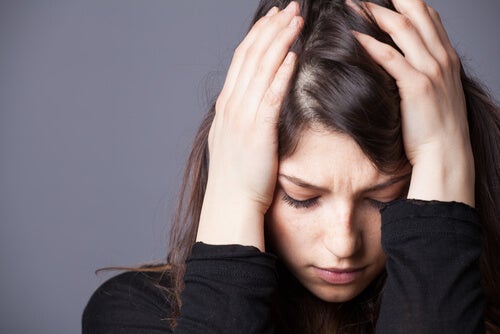It can be difficult to deal with both depression and anxiety at the same time. You must not only deal with the pain that these emotions create, but you must also deal with the challenging events that caused these emotions in the first place.
Of course, it’s natural to feel sad or frightened when going through a difficult moment; these feelings are unavoidable. Sadness and stress, on the other hand, can have a negative impact on us. These emotions might be powerful, persist longer than expected, or creep up on us without our knowledge. So, if you believe that depression and anxiety are interfering with your well-being and capacity to enjoy life, this information about mixed anxiety and depressive disorder may be beneficial to you.
Understanding Mixed Anxiety Depressive Disorder
Mixed Anxiety-Depressive Disorder is a mental health illness in which a person has symptoms of both depression and anxiety at the same time. Individuals with Mixed Anxiety-Depressive Disorder, unlike those with Major Depressive Disorder or Generalized Anxiety Disorder, may not meet all of the diagnostic criteria for either a mood disorder or an anxiety disorder. Regardless, Mixed Anxiety-Depressive Disorder is a significant and devastating mental health disorder, and the combination of mood and anxiety symptoms can be extremely difficult for the individual to manage.
Individuals’ depressed and anxious sentiments frequently feed one another; for example, depressive symptoms may induce a person to postpone or avoid activities, causing them to feel stressed and worried when they are no longer able to put things off. Similarly, anxiety may induce people to avoid activities they would typically like, heightening their feelings of depression. Individuals may have Mixed Anxiety-Depressive Disorder if their symptoms endure at least four months and interfere with their employment, school, or social activities.
Mixed Anxiety-Depressive Disorder Symptoms
Mixed Anxiety-Depressive Disorder symptoms differ from person to person but may involve one or more of the following:
Physical Symptoms of Mixed Anxiety and Depressive Disorder
- Aches and stress in the muscles
- Nausea.
- Unusually fatigued.
- Appetite alteration
- Sweating excessively.
- Sexual interest has waned.
- Inadvertently losing or gaining weight.
Mixed Anxiety-Depressive Disorder Psychological Symptoms
- Constantly concerned.
- Feeling depressed or despairing.
- Negative thinking.
- Feeling uninspired.
- Becoming irritated.
- Having difficulty concentrating.
- Being unable to do the things you used to like.
Any of these characteristics could be a symptom of sadness or anxiety. Also, remember that only a certified mental health practitioner can diagnose depression or anxiety after an in-depth examination of your unique condition and circumstances. If you are concerned about how you have been feeling, please consult with your usual healthcare practitioner as soon as possible.
What Is the Root Cause of Mixed Anxiety Depressive Disorder?
Anxiety and depression are not caused by a single factor. Anxiety and depression are most usually the results of a mix of causes.
There is also strong evidence that genes play a role in anxiety and depression. These problems run in families, and having a parent or sibling who has a mental health disorder increases your chances of developing anxiety or depression.
Life experiences that are stressful can play a role in the development of anxiety and depression. Unemployment, illness, childbirth, divorce, financial insecurity, moving, retirement, or starting a new job can all have a negative impact on your mental health. Ongoing disagreements with others, loneliness, and the loss of someone or something important can all have a negative impact on our well-being.
Your personality structure might also have an impact on how you feel. Being self-critical or perfectionistic, setting high standards for oneself, or seeing the “glass half empty” can all raise your risk of getting anxiety and depression.
Physical sickness, drugs, and pharmaceuticals are other causes that should not be neglected. Anxiety or depression symptoms can be caused by glandular fever, influenza, hepatitis, thyroid hormones, anemia, diabetes, birth control pills, alcohol and other substances of abuse, or other medications such as those for heart or blood pressure disorders.
Anxiety can also lead to depression and vice versa. Constantly being nervous and on edge can leave you exhausted, negative, and unproductive. When you’re continuously worried, getting enthused about things or enjoying yourself is difficult. Similarly, people suffering from depression frequently think negatively and expect the worst, which can cause them to worry about themselves, the future, and what others think of them. It can be a never-ending loop.
How to Handle Mixed Anxiety and Depressive Disorder
There are numerous treatments available for mixed anxiety and depressive disorder. Fortunately, many of these therapies, such as psychoeducation, cognitive-behavioral therapy (CBT), and medicines, are beneficial for both.
Psychoeducation
Psychoeducation means learning how anxiety and depression develop and why they persist. This type of information is incredibly valuable. This knowledge base has the potential to offer someone more control over their disorder, reducing feelings of uncertainty and helplessness and increasing overall well-being. Providing education to families or carers also allows them to offer support.
The most significant pieces of information for a person with anxiety and depression include:
- Depression and anxiety are common disorders.
- Depression and anxiety are not signs of weakness or character defects.
- Treatment is effective, and there are numerous treatment options available. Most people can find a treatment that works for them.
- Recovery is the rule, not the exception.
Medication
Medication may be the first line of treatment for some persons suffering from anxiety or depression. Despite the fact that these drugs are commonly referred to as antidepressants, they are useful for both anxiety and depression.
Medication is often advised if a person is in a seriously sad mood or is experiencing intense worry. Antidepressant medicines are rarely suggested as a first-line treatment for mild to moderate depression.
Antidepressant medicines operate in a variety of ways. You may need to try more than one type of medication to find the one that works best for you. During the early phases of taking drugs, keep in frequent communication with your prescribing physician; the side effects can often be tough to deal with.
When taking these drugs, keep the following in mind:
- Take the drug exactly as directed.
- Do not stop the drug without first consulting with the doctor who recommended it.
- As your body adjusts, the side effects become less severe. Contact your doctor if the adverse effects do not go away or become unreasonable.
- If you stop taking the prescription after you feel better, your depression may return.
Cognitive Behavioral Therapy (CBT)
CBT is an effective treatment for depression and anxiety, either alone or in combination with medication. This treatment involves learning skills such as:
- Manage the negative thoughts that are characteristic of anxiety and depression.
- Combat emotions of sadness and hopelessness, as well as lack of energy, even when not physically active.
- Overcome the feelings of fear and worry, and re-engage in activities you might have stopped doing due to anxiety.
CBT is often indicated when:
- CBT has already proven useful to the individual.
- The individual wishes to take an active role in their recovery.
- The individual wants to learn skills that will help them in recovering and maintaining their health.
- A competent, qualified clinician with expertise in CBT is available, or the individual is willing to use internet CBT (iCBT).
- The person refuses to take medicine or has a medical condition that prevents them from taking antidepressants.
- The individual prefers CBT or iCBT.
Related: ANXIETY IN RELATIONSHIPS: PROMINENT SYMPTOMS AND HOW-TO-GUIDE
Self-Help Techniques for Coping with Mixed Anxiety and Depressive Disorder
#1. Cognitive Techniques
People suffering from anxiety and depression frequently have a negative thinking style. They may feel insufficient and as though a disaster is just around the corner. When something horrible happens, they blame themselves; when something wonderful happens, they blame someone else or dismiss it as a coincidence. They may become fixated on indicators that something horrible is about to happen while ignoring signs that everything is well.
Cognitive techniques seek to assist people in identifying and shifting problematic thinking habits. People can begin to feel more hopeful, confident, and grounded by learning to reframe their thinking about life.
People realize they have some say over what occurs to them. Having these skills, like having behavioral methods, minimizes relapse and recurrence of anxiety and depression.
#2. Behavioral Techniques
Avoidance is a significant aspect of anxiety and depression. When you avoid exciting or crucial experiences because of the terrible emotions they elicit, you are engaging in avoidance. For example, skipping a run because you’re embarrassed about your fitness, leaving a party early because you’re embarrassed or uncomfortable, or even not applying for that new job because you’re frightened of rejection.
Because avoidance deprives you of the opportunity to have fun, connect with others, achieve goals, and overcome your anxieties, it perpetuates anxiety and despair. As a result, behavioral tactics emphasize avoidance. As an example:
- Set daily activity goals. Make a list of the activities you intend to engage in at various times throughout the day to plan whole days of meaningful activity. Maintain as much consistency as possible with this plan.
- What kinds of activities do you enjoy? Increase the amount of time you devote to these pleasurable pursuits.
- What activities take you slightly outside of your comfort zone? See what happens if you try something new that isn’t too intimidating.
- Recognize and reward yourself for your efforts. Request that those around you encourage and praise you for each modest step you take. Recovering from depression is similar to relearning how to walk after breaking your leg.
Read Also: DISORGANIZED SCHIZOPHRENIA: Types, Symptoms, and Treatment
Coping with Mixed Anxiety Depressive Disorder Symptoms
A few minor modifications can sometimes significantly affect how you feel. Here are a few strategies for dealing with the symptoms of mixed anxiety and depressive disorder.
#1. Muscle tension management
- Muscle tension can be exacerbated by inactivity. Throughout the day, try to stand up and move around a little.
- In the evening, do some moderate stretches to relieve stress and improve feelings of relaxation.
- Take some time out of your day to breathe deeply and deliberately relax your muscles from head to toe. You might be amazed at how much anxiety you carry around with you without even realizing it.
- If your muscular discomfort is severe or prolonged, consult your doctor or a physiotherapist for more guidance.
#2. Dealing with Sleep Issues
- Every morning, get up at the same hour.
- Sleeping during the day should be avoided.
- If you drink a lot of tea and coffee, you should cut back (no more than two or three cups per day and none after about 4:00 PM).
- Do not lie awake for more than thirty minutes; instead, get up and engage in a calming activity.
#3. Reducing worry and negative thinking
Put your thoughts to good use. Rather than continuously identifying problems, choose one or two that seem particularly pressing and make a decision to address them. You could enlist the assistance of a friend.
Take the following steps:
- Describe the issue (or objective) in detail.
- Make a list of five or six potential solutions to the problem. Write down any and all thoughts that come to you, not just the good ones.
- Consider the advantages and disadvantages of each concept.
- Choose the solution that best meets your requirements.
- Plan out the exact steps you’ll take to put the answer into action.
- After attempting to carry out the plan, evaluate your efforts. Recognize all efforts. If you don’t succeed the first time, try again.
#4. Changing unfavorable emotions and thoughts
Negative thoughts and emotions tend to direct your attention to things that make you feel anxious or unhappy – these thoughts might magnify your issues. People who suffer from anxiety and depression sometimes underestimate their abilities to deal with these issues. A variety of ways may assist you in achieving a more balanced perspective:
- Make a list of your three best characteristics, possibly with the assistance of a friend or relative. Carry the list with you and read it out to yourself whenever you catch yourself thinking negatively.
- Make a list of three difficult things that you handled better than you expected. Read this list if you’re worried about coping if your fears come true.
- Keep a daily journal of all the wonderful or interesting things that happen, and discuss them with your friends when you see them.
- Keep oneself occupied with beneficial things. Avoid allowing yourself too much free time to contemplate.
Is Mixed Anxiety and Depression in Dsm 5?
Mixed anxiety and depressive disorder, or ‘MADD,’ is a separate diagnostic category in ICD-10 but is not in DSM-5.
What Is the 3 3 3 Rule for Anxiety?
Take a breather if you feel anxiety rising. Take a look around. Concentrate on your gaze and the tangible items around you. Then, list three objects you can observe in your surroundings.
Is MADD Serious?
Because MADD is associated with significant disability and impaired health-related quality of life but is not usually a life-threatening condition, treatment should focus on restoring daily living skills and social functioning, as well as preventing an exacerbation of a potentially more serious condition.



